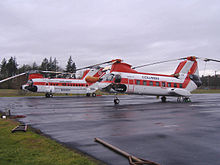
The Boeing Vertol CH-46 Sea Knight is an American medium-lift tandem-rotor transport helicopter powered by twin turboshaft engines. It was designed by Vertol and manufactured by Boeing Vertol following Vertol's acquisition by Boeing.

The Boeing CH-47 Chinook is a tandem-rotor helicopter originally developed by American rotorcraft company Vertol and now manufactured by Boeing Defense, Space & Security. The Chinook is a heavy-lift helicopter that is among the heaviest lifting Western helicopters. Its name, Chinook, is from the Native American Chinook people of Oregon and Washington state.
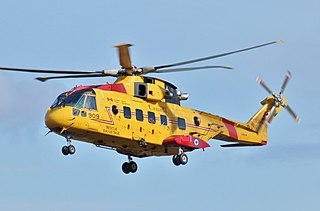
The AgustaWestland CH-149 Cormorant is the Canadian Forces designation for the AgustaWestland AW101, a helicopter used for air-sea rescue in Canada. Developed as a joint venture between Westland Aircraft in the UK and Agusta in Italy, the CH-149 is a medium-lift helicopter for military applications.

The Sikorsky CH-54 Tarhe is an American twin-engine heavy-lift helicopter designed by Sikorsky Aircraft for the United States Army. It is named after Tarhe, an 18th-century chief of the Wyandot Indian tribe whose nickname was "The Crane". The civil version is the Sikorsky S-64 Skycrane.
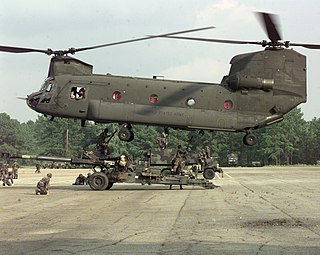
Boeing Rotorcraft Systems is the former name of an American aircraft manufacturer, now known as Vertical Lift division of Boeing Defense, Space & Security.
Piasecki Helicopter Corporation designed and manufactured helicopters in Philadelphia and nearby Morton, Pennsylvania, in the late 1940s and the 1950s. Its founder, Frank Piasecki, was ousted in 1956 and started a new company, Piasecki Aircraft. Piasecki Helicopter was renamed Vertol Corporation in early 1956. Vertol was acquired by Boeing in 1960 and renamed Boeing Vertol.
New York Airways was an American helicopter airline in the New York City area, founded in 1949 as a mail and cargo carrier. On 9 July 1953 it may have been the first scheduled helicopter airline to carry passengers in the United States, with headquarters at LaGuardia Airport. Although primarily a helicopter airline operator with scheduled passenger operations, New York Airways also flew fixed wing aircraft, such as the de Havilland Canada DHC-6 Twin Otter 19-passenger STOL twin turboprop aircraft.

The Piasecki H-21 Workhorse/Shawnee is an American helicopter, the fourth of a line of tandem rotor helicopters designed and built by Piasecki Helicopter. Commonly called "the flying banana", it was a multi-mission helicopter, capable of being fitted with wheels, skis or floats.

The Sikorsky S-64 Skycrane is an American twin-engine heavy-lift helicopter. It is the civil version of the United States Army's CH-54 Tarhe. It is currently produced as the S-64 Aircrane by Erickson Inc.

The Sikorsky CH-53K King Stallion is a heavy-lift cargo helicopter designed and produced by Sikorsky Aircraft. The King Stallion is an evolution of the long running CH-53 series of helicopters which have been in continuous service since 1966, and features three uprated 7,500 shp (5,590 kW) engines, new composite rotor blades, and a wider aircraft cabin than its predecessors. It is the largest and heaviest helicopter in the U.S. military.

The Sikorsky S-72 was an experimental compound helicopter developed by helicopter manufacturer Sikorsky Aircraft.
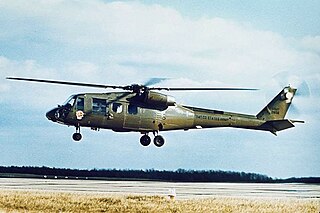
The Boeing Vertol YUH-61 was a twin turbine-engined, medium-lift, military assault/utility helicopter. The YUH-61 was the runner-up in the United States Army Utility Tactical Transport Aircraft System (UTTAS) competition in the early 1970s to replace the Bell UH-1 Iroquois helicopter. At the end of the flyoff program, Sikorsky Aircraft was awarded a contract to develop and build its UH-60A entry.

An aerial crane or flying crane is a helicopter used to lift heavy or awkward loads. As aerial cranes, helicopters carry loads connected to long cables or slings in order to place heavy equipment when other methods are not available or economically feasible, or when the job must be accomplished in remote or inaccessible areas, such as the tops of tall buildings or the top of a hill or mountain, far from the nearest road. Helicopters were first used as aerial cranes in the 1950s, but it was not until the 1960s that their popularity in construction and other industries began to catch on. The most consistent use of helicopters as aerial cranes is in the logging industry to lift large trees out of rugged terrain where vehicles are not able to reach, or where environmental concerns prohibit roadbuilding. These operations are referred to as longline because of the long, single sling line used to carry the load.
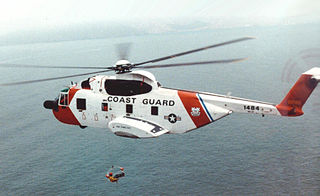
The Sikorsky S-61R is a twin-engine helicopter used in transport or search and rescue roles. A developed version of the S-61/SH-3 Sea King, the S-61R was also built under license by Agusta as the AS-61R. The S-61R served in the United States Air Force as the CH-3C/E Sea King and the HH-3E Jolly Green Giant, and with the United States Coast Guard as the HH-3F, nicknamed "Pelican".

The Sikorsky S-61L and S-61N are civil variants of the SH-3 Sea King military helicopter. It was developed and produced by the American helicopter manufacturer Sikorsky Aircraft.

On 6 November 1986, a Boeing-Vertol Model 234LR Chinook helicopter returning workers from the Brent oilfield crashed on approach to land at Sumburgh Airport in the Shetland Islands. At 2.5 mi (4.0 km) from the runway the helicopter had a catastrophic forward transmission failure which caused the tandem rotor blades to collide. The helicopter crashed into the sea and sank. Forty-three passengers and two crew members were killed in the crash; one passenger and one crew member survived with injuries.

British Airways Helicopters was a British helicopter airline from 1964 to 1986.
The Sikorsky S-73 was a proposed aircraft design to meet the United States Army requirement in 1970 for a Heavy Lift Helicopter (HLH) capable of carrying 45,000 lb, a lifting capacity more than twice that of Sikorsky's most powerful helicopter at that time.
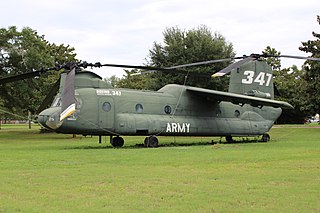
The Boeing Vertol BV-347 is an experimental helicopter built by Boeing Vertol from a converted CH-47A Chinook.

